Wuhan government
| Wuhan nationalist government
武漢國民政府 Wǔhàn guómín zhèngfǔ | |||||||||||
|---|---|---|---|---|---|---|---|---|---|---|---|
| 5 December 1926–21 September 1927 | |||||||||||
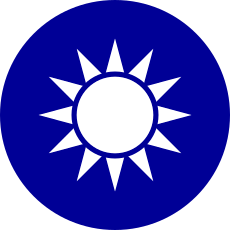 Blue Sky with a White Sun
| |||||||||||
| Capital | Wuhan | ||||||||||
| Chairman | |||||||||||
• 1927 | Wang Jingwei | ||||||||||
| Historical era | Warlord era | ||||||||||
• Established | 5 December 1926 | ||||||||||
• Disestablished | 21 September 1927 | ||||||||||
| |||||||||||
The Wuhan nationalist government (Chinese: 武漢國民政府), also simply known as the Wuhan government[1] or Wuhan regime,[2] was a left-wing nationalist government of China led by Wang Jingwei, and based in Wuhan from 5 December 1926 to 21 September 1927.
History
Background
Despite Kuomintang (KMT) founder Sun Yat-sen's policy of collaborating with the Communist Party of China (CPC), a discrepancy existed between the two parties' ultimate goals for the revolution, and there had been constant conflict between them, such as the March 1926 Canton Coup. During the Northern Expedition, the labour movements led by the Communist Party endangered commercial interests' support of the KMT. Land Reform incited further dissatisfaction among generals and soldiers in the National Revolutionary Army who came from landowning families. For example, the landholding family of General He Jian were paraded through the streets as criminals by communists.
Joseph Stalin tried to persuade the small Chinese Communist Party to merge with the Kuomintang to bring about a bourgeois revolution before attempting to bring about a Soviet-style working class revolution.[3] Stalin funded the KMT during the expedition.[4] Stalin said that Chiang was the only one capable of defeating the imperialists, and that his forces were to be squeezed for all usefulness like a lemon before being discarded.[5] It was under these circumstances that a divergence between the KMT and CPC appeared. KMT rightist figures like Chiang Kai-shek pushed for the "complete clearance of the Communist Party". Meanwhile, KMT leftist, CPC and the Communist International were alarmed and decided to support the leftist leader Wang Jingwei who previously had been exiled abroad.[6]
Formation of the Wuhan government

The National Revolutionary Army (NRA), military arm of the Kuomintang (KMT), captured the three cities of Wuchang, Hankou, and Hanyang in a series of battles from August to October 1926 during the early stage of the Northern Expedition,[2][7] and merged their municipal governments to form Wuhan.[8] After the Wuhan area had fallen to the KMT, local workers organized themselves into left-leaning trade unions, which grew to around 300,000 members by the end of the year.[1] Trade unions also emerged in other NRA-held cities, while peasant uprisings spread throughout the countryside.[9] Backed by these emerging mass-movements,[2][10] members of the Kuomintang relocated from Guangzhou to Wuhan, and formed a new nationalist government in December.[11][12] Despite this, Chiang Kai-shek[2], who had been leader of the KMT since the Canton Coup in March 1926,[13] opted to stay at his military headquarters in Nanchang, Jiangxi. He did not wanted to become involved in the politics at Wuhan, instead preferring to focus on the conquest of the rest of China, while maintaining his independence from other KMT leaders.[2][12] The Wuhan government was dominated by leftist KMT politicians from the beginning, and with the aid of the Communist Party of China[14][10], as well as widespread grassroots support,[2] the leftist politicians transformed Wuhan into "a seedbed for revolution"[14], while portraying themselves as the sole legitimate leadership of the KMT.[15] Controlling much of Hunan, Hubei, Guangdong and Jiangxi[16], the Wuhan government began challenging Chiang's authority[2], and launched a propaganda campaign against him from January 1927. On 10 March, the Wuhan leadership even stripped Chiang of much of his formal military authority, though refrained from deposing him as commander-in-chief. At the same time, the Communist Party became a equal partner in the Wuhan government, sharing power with the KMT leftists.[2] In response to these developments, Chiang started to rally anti-communist elements in the KMT and NRA around him.[17]
Meanwhile, the Wuhan government began to face severe administrative problems. While the grassroots movements had originally been among its most important supporters, their actions sowed social instability and economic chaos in the areas under its control. They drove out foreigners, including several economically important firms, and suppressed middle and small merchants. Although the Wuhan government was reluctant to alienate the communist-leaning workers, they could hardly tolerate the ongoing social trend, as they were beginning to create severe financial downturn. By May 1927, the Wuhan government had an expenditure of 10 million Chinese dollars in contrast to a revenue of just 1.8 million dollars. Inflation and mass layoffs further worsened the economic situation.[1] Furthermore, the countryside began to descend into chaos, as peasant rebels took control of large swaths of land.[9] The communists generally claimed that the rural insurgents were under their control,[18] but in reality these insurgents were often independent groups or simply found themselves allied with the leftists.[19][20] Regardless of the political position of the peasants, the Wuhan government tried to sway them to their side through a reform program, although the planned agrarian reform never really took off.[21] Instead, the rural insurgents started to govern themselves, which in response alienated much of the NRA officials as the Kuomintang military leadership were generally opposed to peasant rule.[22]
The Nanjing–Wuhan split
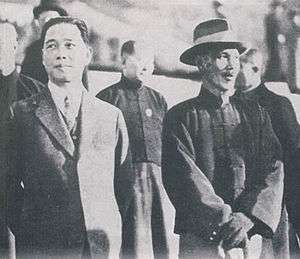
On 1 April 1927, Wang Jingwei returned to China, and arrived at Shanghai, which had been occupied by the National Revolutionary Army. On 3 April, Chiang Kai-shek and Li Zongren met with him to urge him to end the collaborative relations with the CPC as the president of the Wuhan government, but Wang stated that he would "pick up side with the workers and farmers",[23] and proposed to tolerate the Communists for the time being. On 4 April in a KMT senior officials' meeting in Shanghai, Wu Zhihui even knelt down to beg for Wang's agreement.[24] The meeting only managed to proceed with Chiang Kai-shek's and others' mediation. In the fourth Plenary Session of the 2nd KMT Central Committee held in Nanjing, a consensus was reached on how to resolve the KMT-CPC dispute:
Consent to Wang Jingwei's proposal of temporary tolerance of the Communist Party. The fourth plenary session will come up with a plan to settle the dispute. Before this session, the following actions proposed by Chiang Kai-shek will be carried out to solve any emergency:
- First, inform communist leader Chen Duxiu to notify communists in KMT-controlled areas to halt their activities before the pending meeting.
- Second, since the government had come under the control of the Communist Party after moving to Hubei and some unsound commands have been made, should these damage the party's prospects, they can be ignored until the party's fourth plenary session.
- Third, the army should order senior officials to suppress Communist Party organisations and groups that are causing disturbances.
- Workers' pickets and other armed groups should obey the Commander-in-Chief (Chiang), and those who do not comply will be labelled as counter-revolutionary and be banned.
However, on 5 April, Wang decided to take the initiative by privately publishing with Chen Duxiu the "Joint Declaration of the Leaders of the Nationalist and Communist Parties", in which he proclaimed a permanent collaboration between the two parties. This declaration drove the anti-communist KMT officials into a rage. Wu Zhihui, who had previously knelt down to beg Wang, mocked him as paternalistic, "the parent of the KMT". Wang left Shanghai that night for Wuhan, the government there being made up mostly of the communists and the KMT left-wing.
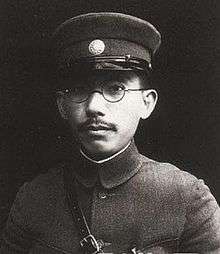
Wang Jingwei arrived at Wuhan on 10 April and met Tang Shengzhi and Tan Yankai, nominally to call together members of central committee to attend the fourth plenary session of the 2nd KMT Central Committee held in Nanjing. He thought that the meeting would be held as planned, but unexpectedly, Chiang Kai-shek rallied the anti-communist factions of Hu Hanmin and Li Jishen to "exterminate the communists" on 12 April, and formed a rival government in Nanjing (Chinese: 南京国民政府).[25][26] Incensed and shocked, Wang declared that Chiang had been "expelled from the party and dismissed from all his posts", namely, the KMT central executive membership.[27] The Wuhan government responded by accusing Chiang and his followers of being the puppets of foreign imperialists and criticised his close cooperation with Shanghai's merchant class, arguing that he helped to oppress workers and peasants.[28] On 18 April, the same day of the formation of the Nanjing government, during a public rally in Wuhan, Wang delivered a speech in which he severely condemned Chiang Kai-shek. The Nanjing and Wuhan governments were thus officially split.
To prevent the Wuhan government from sending forces against the Nanjing government, Guangxi warlord Li Zongren and his subordinate Ying Yuhan went to Jiangxi and Wuhan respectively, to lobby Wang and other armed forces in Wuhan. They managed to convince both sides to continue the Northern Expedition in mutual non-interference, and on the 19th the Wuhan government appointed Hunan warlord Tang Shengzhi as Commander-in-chief to proceed with the Northern expedition. On 1 May, Chiang Kai Shek also continued with the Northern Expedition independently.
By this point, however, the anti-communist sentiment in the NRA had grown significantly as result of internal tensions in Wuhan-controlled areas as well as agitation by the Nanjing faction. As result, the NRA's 14th Division under Xia Douyin rebelled in western Henan and marched against Wuhan in May, supported by Sichuan warlord Yang Shen. Though Xia was defeated by Wuhan loyalist Ye Ting's 24th Division and Yang's attack was repelled, the open rebellion further undermined the confidence of political and military leaders in the KMT toward the Wuhan leadership.[29]
The "May Instructions"
On 1 June, Communist International (Comintern) representative M. N. Roy arrived in Wuhan with orders for the government, which later became known as the "May Instructions". These orders were first relayed to Wang Jingwei in confidence. The instructions presented the following demands:
- Insistence that every effort be made for land to be occupied by the Communist Party. However, actions that are too aggressive should be avoided, and officials and soldiers' lands should be exempted. Make concessions to artisans, merchants and small landlords.
- Mobilize 20,000 communists and 50,000 revolutionary workers and farmers to raise an army.
- Recruit new leaders from the workers and farmers of the lower stratum to join KMT so as to alter the composition of the party. Expel all those of "old mindsets".
- Establish a revolutionary military court headed by well-known party officials and non-communists, to punish reactionary officials.[30]
Wang Jingwei believed that if these instructions were followed the KMT might be destroyed, but continued negotiations with the Soviets. He requested that the Soviet Union provide 15 million Soviet rubles in aid, but Moscow offered only 2 million.[31] Later, Wang vented his frustration to chief Soviet adviser to the KMT Mikhail Borodin, and considered sending him back to the Soviet Union.
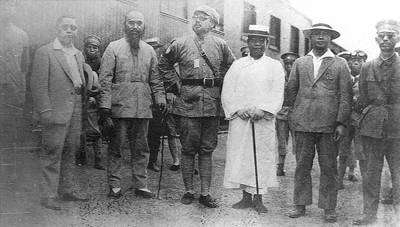
The "May Instructions" compelled Wang to diverge from the communists, but did nothing to quell his dislike for Chiang. In an effort to counter both the CPC and Chiang's Nanjing faction simultaneously, Wang sought the backing of Guominjun leader Feng Yuxiang, who controlled large parts of northern China. Without informing the CPC[32], he sent Deng Yanda to meet with Feng at Zhengzhou on 8–10 June.[33] In the meeting, though Wang had offered Feng all possible concessions, Feng still insisted that Wang take the lead in parting from the communists. Given that Wuhan military commander-in-chief Tang Shengzhi had been badly wounded in a battle with warlord Zhang Zuolin in Henan province, hampering Wuhan's ability to defend itself, and that Feng had taken that opportunity to seize control of Henan, Wang Jingwei had to do as he requested, lest Wuhan be subject to an attack by Feng's forces.[34]
Unbeknownst to Wang Jingwei, Feng Yuxiang had dispatched Li Mingzhong to get in touch with Chiang Kai-shek, and managed to meet him in Xuzhou on 19 June. Compared to the nominal titles that Wang had offered, Chiang agreed to provide Feng with 2.5 million yuan monthly from July 1927 to cover military expenditures, and did not demand that he sever ties with the Wuhan government.[33] Feng was immensely satisfied, and said that he wished he could have met Chiang earlier.[35] After the meeting, Feng wired a message to Wuhan in the name of both himself and Chiang, and demanded that the Wuhan government expel Soviet representative Mikhail Borodin, carry out a purge of communists within the party and finish the Northern Expedition, which forced Wuhan into an even weaker position.
Views on the "May Instructions" varied within the Communist Party of China. When Chen Duxiu first read it he thought it did not fit into China's reality, and telegraphed back indicating that it was hard to be enforced. This, however, dissatisfied the Communist Party of Soviet Union and the Comintern.[36] "Article 11 on the KMT–CPC Union" had been passed by the expanded Central Committee on 30 June, and it suggested that the communists should consider breaking ties with the Wuhan government.[37]
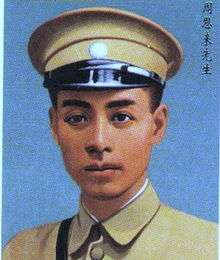
On 4 July, the CPC held an expanded political bureau meeting on San Jiao Jie street, Hankou, Wuhan. General secretary Chen Duxiu and Borodin insisted that the instructions not be followed for the time being, but this was opposed by radical elements in the party. Apart from this, the two leaders decreed that the workers and farmers' movements in Hunan and Hubei be put on hold so as to rescue the united front with the KMT left wing. However, the Comintern deemed that by pausing workers and farmers' movements to maintain KMT membership status Chen and Borodin were guilty of "opportunism" and recalled Borodin to Russia immediately. On 8 July, the Comintern requested that all communists withdraw from KMT. On 12 July, Chen Duxiu's was dismissed as CPC general secretary, and a leaders' group constituting Zhou Enlai, Li Lisan, Li Weihan, Zhang Tailei and Zhang Guotao was formed (Qu Qiubai later joined them). Researcher Zhang Yufa speculates that the Comintern's intention was for an armed insurrection to seize leadership of revolutionary movements from the KMT. On 13 July, CPC issued a declaration that it would officially withdraw from the KMT, and reproached Wang as "openly sponsoring counter-revolutionaries".[38]
Break with CPC and dissolution
Continuous unrest by trade unionists and communist-aligned peasant movements, along with Soviet interference in Wuhan's affairs, placed constant pressure on the Wuhan government, which subsequently moved to purge communists from its ranks on 15 July 1927, in what is known as the "715 Incident".[39] In response to the purge, the Chinese Communist Party initiated the Nanchang uprising against the Wuhan government on 1 August 1927, after which Wuhan agreed to reunify with the Nanjing nationalist government. On 21 September, the Wuhan Political Council made an official statement to the effect that they would relocate to Nanjing, ending the Wuhan government.[40]
Military forces
Though most of the NRA was loyal to Chiang Kai-shek or various warlords who joined the KMT before or during the Northern Expedition, the Wuhan government commanded its own military force. The so-called "Wuhan Army" was less strong and well-armed than the rest of the NRA,[41][42] and suffered from the defection of right-leaning commanders and their troops to Chiang's side.[43]
Commanded by Tang Shengzhi, the Wuhan army was too weak in numbers and equipment to truly rival Chiang's followers or to defeat the northern warlords.[44] Nevertheless, a 70,000-strong army loyal to the Wuhan government launched its own "Northern Expedition" in April 1927, aiming to conquer Henan from the northern warlords. Though lacking in arms, this force was joined by deserters from Wu Peifu's forces and managed to push back the warlord Zhang Xueliang, but suffered 14,000 casualties while doing so, and was forced to return to Wuhan. Unable to sufficiently replenish its numbers, the Wuhan army was eventually defeated by Chiang-loyal NRA forces.[41]
References
Citations
- 1 2 3 Wu 1969, p. 128.
- 1 2 3 4 5 6 7 8 Wu 1969, p. 126.
- ↑ Dutt 1970, pp. 5–21.
- ↑ Zarrow 2005, p. 233.
- ↑ Moss 2005, p. 282.
- ↑ Guo 1995, p. 59.
- ↑ Fenby (2004), pp. 119–121.
- ↑ MacKinnon (2008), pp. 12–13.
- 1 2 Wu 1969, pp. 128–129.
- 1 2 Coble 1986, p. 5.
- ↑ Wilbur 1983, p. 78.
- 1 2 Fenby (2004), p. 122.
- ↑ Wilbur 1983, p. 47.
- 1 2 Fenby (2004), p. 124.
- ↑ Fenby (2004), pp. 124–125.
- ↑ Wu 1969, pp. 126, 132.
- ↑ Wu 1969, pp. 126–127.
- ↑ Wu 1969, p. 129.
- ↑ Bianco (1972), p. 213–215, 219–224.
- ↑ Ch'en (2018), p. 34.
- ↑ Wu 1969, pp. 129–131.
- ↑ Wu 1969, pp. 131–133.
- ↑ 《真实的汪精卫》,第二部分之三:从拥共到反共
- ↑ Li, p. 323.
- ↑ Wilbur 1983, pp. 110–112.
- ↑ Wu 1969, p. 127.
- ↑ 1927年4月17日中国国民党中央执行委员会通电
- ↑ Coble 1986, p. 32.
- ↑ Wu 1969, pp. 132–133.
- ↑ 《联共(布)中央政治局会议第107号(特字第85号)记录》,1927年6月2日,《联共(布)、共产国际与中国国民革命运动(1926-1927)》(下),第298-299页。
- ↑ 《斯大林给莫洛托夫的信》,1927年6月24日;《联共(布)中央政治局会议第113号(特字第91号)记录》,1927年6月27日,《联共(布)、共产国际与中国国民革命运动》(下),第352,364页。
- ↑ Guo 1995, p. 74.
- 1 2 Zhao 1996, p. 97.
- ↑ Guo 1995, p. 75.
- ↑ 冯玉祥自传《我的生活》:徐州与蒋中正一见"见其风采及言谈态度,无不使我敬慕,大有相见恨晚之情"
- ↑ "1927年大革命失败的主要原因与陈独秀的责任". 66论文. 8 April 2008. Archived from the original on 19 July 2012. Retrieved 31 March 2017.
- ↑ 统战部 (2007). "第一次国共合作破裂的原因及其教训". 中国共产党新闻网. Retrieved 25 December 2016.
- ↑ Zhang 1999, pp. 348–349.
- ↑ Jacobs 1981, p. 284.
- ↑ Wilbur 1983, pp. 157–159.
- 1 2 Jowett 2014, p. 42.
- ↑ Kotkin 2014, p. 629.
- ↑ Wu 1969, pp. 133–134.
- ↑ Jowett 2013, p. 159.
Bibliography
- Bianco, Lucien (1972). "Secret Socities and Peasant Self-Defense, 1921–1933". In Jean Chesneaux. Popular Movements and Secret Societies in China 1840-1950. Stanford, California: Stanford University Press. pp. 213–224.
- Ch'en, Jerome (2018) [1st pub. 1992]. The Highlanders of Central China: A History 1895-1937. Abingdon-on-Thames, New York City: Routledge.
- Coble, Parks M. (1986). The Shanghai Capitalists and the Nationalist Government, 1927-1937. Cambridge, Massachusetts: Harvard University Press.
- Fenby, Jonathan (2004). Generalissimo: Chiang Kai-shek and the China He Lost. London: Simon & Schuster. ISBN 0743231449.
- Jowett, Philip S. (2013). China's Wars. Rousing the Dragon 1894–1949. Oxford: Osprey Publishing. ISBN 978-1782004073.
- Jowett, Philip S. (2014). The Armies of Warlord China 1911–1928. Atglen, Pennsylvania: Schiffer Publishing. ISBN 978-0764343452.
- Kotkin, Stephen (2014). Stalin: Paradoxes of Power, 1878–1928. London: Allen Lane. ISBN 978-0-713-99944-0.
- Wilbur, C. Martin (1983). The Nationalist Revolution in China, 1923-1928. Cambridge: Cambridge University Press. ISBN 978-0521318648.
- Wu, Tien-wei (November 1969). "A Review of the Wuhan Debacle: The Kuomintang-Communist Split of 1927". The Journal of Asian Studies. 29 (1): 125–143. JSTOR 2942527.
- MacKinnon, Stephen R. (2008). Wuhan, 1938: War, Refugees, and the Making of Modern China. University of California Press. ISBN 9780520254459.
- Jacobs, Dan N. (1981). Borodin: Stalin's Man in China. Cambridge, Massachusetts: Harvard University Press. ISBN 0-674-07910-8.
- Zhang, Yufa (1999). 中國近代現代史 [Zhong guo jin dai xian dai shi] (in Chinese). Taipei: 東華. ISBN 957-636-217-2.
- Walter Moss (2005). A history of Russia: Since 1855. Volume 2 of A History of Russia (2, illustrated ed.). Anthem Press. ISBN 1-84331-034-1. Retrieved 1 January 2011.
- Peter Gue Zarrow (2005). China in war and revolution, 1895–1949. Volume 1 of Asia's transformations (illustrated ed.). Psychology Press. ISBN 0-415-36447-7. Retrieved 1 January 2011.
- Guo Baoping (1995). 蒋介石三次下野秘录 [Jiang Jieshi san ci xia ye mi lu] (in Chinese). 中国档案出版社. ISBN 9787800195259.
- Joseph Stalin (1970). Dutt, Suren, ed. On Chinese Revolution. Calcutta: New Book Centre.
- Zhao, Suisheng (1996). Power by Design: Constitution-Making in Nationalist China. University of Hawaii Press. p. 97. ISBN 9780824817213.
- Li, Zongren. 李宗仁回憶錄 [Memoirs of Li Zongren] (in Chinese).
